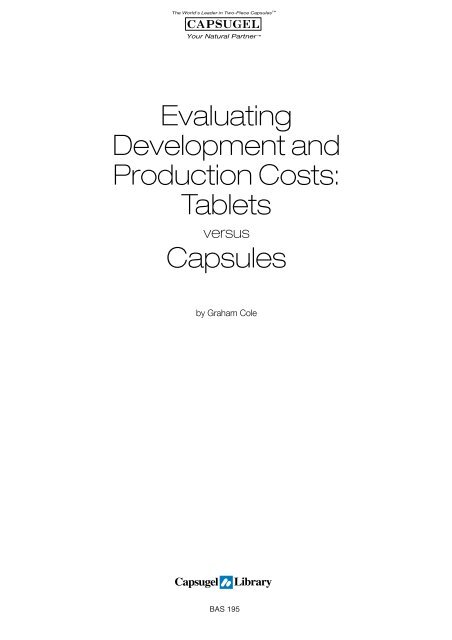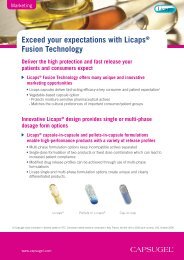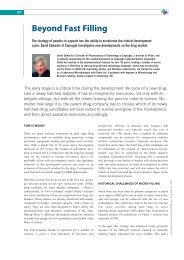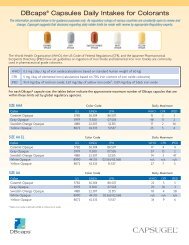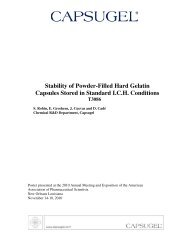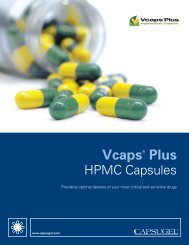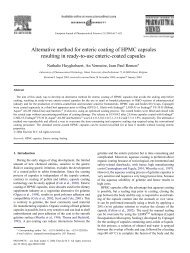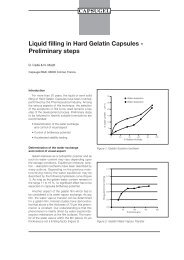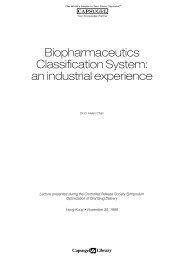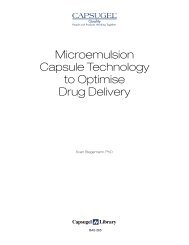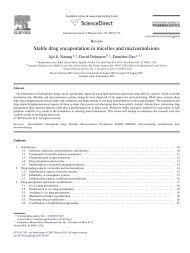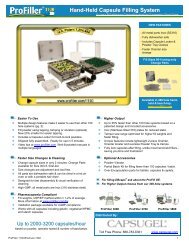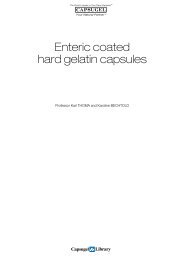Evaluating Development and Production Costs: Tablets ... - Capsugel
Evaluating Development and Production Costs: Tablets ... - Capsugel
Evaluating Development and Production Costs: Tablets ... - Capsugel
You also want an ePaper? Increase the reach of your titles
YUMPU automatically turns print PDFs into web optimized ePapers that Google loves.
<strong>Evaluating</strong><strong>Development</strong> <strong>and</strong><strong>Production</strong> <strong>Costs</strong>:<strong>Tablets</strong>versusCapsulesby Graham ColeBAS 195
However, this criterion has now changed <strong>and</strong>many major pharmaceutical companies producecoloured film-coated tablets in a variety of shapes, amuch more expensive operation.There are a number of reasons for this, <strong>and</strong>some examples are• coated tablets are easier to h<strong>and</strong>le <strong>and</strong> pack inhigh-speed packaging lines• elimination of particles <strong>and</strong> dust from tabletsurface (improved containment)• protection from atmospheric oxidation, moisture<strong>and</strong> improved stability• identification of the company logo to doctor<strong>and</strong> patient• makes it more difficult for generic companies tocompete.The technology of film coating has now developedto an extent that it can be accomplished reasonablyquickly <strong>and</strong> simply. However, it is not withouta cost <strong>and</strong> it adds risk of failure to the manufacturingoperation.This article will examine <strong>and</strong> quantify some of thecosts using two examples of film-coated tabletscompared with a dry powder product filled into ahard shell gelatin capsule. The two tablet formulationsused were• wet granulated film-coated tablet (Tablet 1)• directly compressed film-coated tablet (Tablet2).FormulationInitially, NCEs are usually only available in verysmall quantities (less than 10 g). In the early stageof formulation, this quantity is used to undertakepre-formulation studies, assess bioavailability, developdosage strengths <strong>and</strong> initiate some stability studies.The quickest way to do this is to use a capsule<strong>and</strong> many companies will start with a capsule formulation<strong>and</strong> then, at a later stage, convert this formulationinto a tablet. It is simple to mix a numberof powders together or just use the active materialin the capsule for these purposes.The three formulations compared in this articleare shown in Table 1. For the purposes of this studythe cost of the active ingredient has been ignored.Table 2 shows the cost of the raw materials <strong>and</strong> thecost of producing batches of 100000 dosage units.An examination of Table 1 shows that the excipientscost almost four times as much for a capsuleas for a tablet. It is also interesting to note that thereTable 2: Raw material <strong>and</strong> batch costs per 100000 (all costs are in US dollars).6
Figure 2: Preparation <strong>and</strong> packagingof capsules.is little difference between a directly compressed tablet<strong>and</strong> a wet granulated tablet <strong>and</strong>, in fact, thatthe directly compressed tablet is more expensive.However, this is only a small part of the overall costin manufacturing a dosage unit. Each of the followingcosts will be examined in some detail:• process equipment <strong>and</strong> processing times• building <strong>and</strong> process utilities• analytical• manning levels• validation.Process equipment costsThe process flow for the manufacture of a wetgranulated filmcoated tablet is shown in Figure 1.Figure 2 shows a comparable process for fillinghard shell gelatin capsules. The process for the manufactureof a directly compressible tablet will be similarto Figure 1 but will eliminate the followingsteps:• dry mix (one of the unit operations)• paste preparation• granulation• fluid bed drying• size classification.Figure 1: Preparation for packagingof film-coated tablets using wetgranulation techniques.The equipment required for each of these processesis shown in Table 3 together with the appropriatecosts.7
Table 3: Equipment list – cost data (US dollars).It can be seen from Table 3 that there is a considerablesaving in capital equipment if a capsule isfilled rather than a tablet manufactured, <strong>and</strong> that thecapsule has an approximate 23% saving even overthe directly compressed tablet.An examination of Figures 1 <strong>and</strong> 2 also showsconsiderable differences in the number of steps requiredto produce the product ready for compressinginto a tablet or filling into a capsule.In these examples it is assumed that Tablet 2<strong>and</strong> the capsule require the same number of processingsteps to reach this point. Three hours is allowedfor these operations.Tablet 1 requires five additional steps to proceedthrough wet granulation, drying <strong>and</strong> size classification.Eight hours is allowed for these additionalstages.Tablet machines generally have much higher outputsthan capsule fillers. Here it is assumed that acapsule machine operates at a filling speed of 2000capsules per min <strong>and</strong> a tablet press operates attwice this speed (that is, 4000 tablets per min). Therelative times for this part of the process are 50 min<strong>and</strong> 25 min respectively.After compression, both tablets require film coating.Four hours has been assumed for the preparationof the film coating suspension/solution <strong>and</strong> thecoating operation. Manning costs have been allocatedat $75/h. This is summarized in Table 4.It is also assumed that the packaging of the finalfilm-coated tablet <strong>and</strong> the filled capsule wilt requirevery similar equipment, for example, blister packs,<strong>and</strong> that this equipment will require similar floorspace, manning levels <strong>and</strong> utilities. For this reasonthe costs of this part of the manufacturing operationare considered to be the same <strong>and</strong> are thereforeignored in this comparative evaluation.Table 5 illustrates the point that, under the assumptionsmade <strong>and</strong> considering only the excipientcosts <strong>and</strong> processing times, the order of costs is now:Tablet 1 > Capsule > Tablet 2 So far no accounthas been taken of capital, building, analytical <strong>and</strong>validation costs.Table 3 quantifies the equipment costs, but doesnot consider building <strong>and</strong> process utilities. It showsthat it is more than 50% cheaper to manufacture acapsule product compared with Tablet 1, <strong>and</strong> forTablet 2 the saving is still more than 20%. If the8
Table 4: Cost of production (US dollars).Table 5: Total production cost (time<strong>and</strong> raw materials) in US dollars.equipment is written off over five years <strong>and</strong> interestrates are 10%, then, taking the capsule as baselevel, the company can save against Tablet 1 morethan $849000 <strong>and</strong> against Tablet 2, $147000.Building layout <strong>and</strong> processutilitiesFigures 3 <strong>and</strong> 4 show two building layouts, onefor tablets <strong>and</strong> one for capsules. The st<strong>and</strong>ard finishesused to design <strong>and</strong> equip each building arethe same. An examination of these two figuresshows that the Capsule Facility is 25% smaller thanthe Tablet Facility. The costs to design, construct<strong>and</strong> equip these facilities, omitting process equipment,is assumed to be $2000 per square metre.There are four services that are costly to install<strong>and</strong> operate:• purified water (PW) system• compressed air• vacuum• heating, ventilating <strong>and</strong> air conditioning (HVAC).For the processes under discussion it could beargued that PW is unnecessary for the capsule process,however, in reality it will be installed, albeit ona smaller scale, as it may be required in cleaningoperations.Compressed air is required on both processeswhereas vacuum is only required in capsule filling toseparate the empty shells. Here again, a vacuumsystem will be installed in a tablet plant as it canalso be used for powder transfer operations <strong>and</strong>cleaning operations.A typical PW system designed to provide onecubic metre of water/h would cost, with installation,$30-40000. It is also an essential requirement foraqueous film coating to monitor <strong>and</strong> maintain levelswithin the pharmacopoeia specification. Compressedair of the required quality is also a costly utilityto maintain. The requirements for film coating in acoating pan with batch sizes of 100 kg are 20 m 3 /hat 20-40 psi (2-3 bar). This air must have a low particlecount, be bacteria free <strong>and</strong> have a low moisturelevel (less than 1.0%) as it is used to atomize<strong>and</strong> spray the film onto the tablet. A typical systemwith a compressor, 0.2 µm filter, dryer, receiver <strong>and</strong>stainless steel pipework system, would cost approximately$60-70000. For the purpose of thisstudy HVAC is considered to be constant for bothsystems. It is recognized that, for various products,both tablets <strong>and</strong> capsules, special conditions maybe required for products that are moisture sensitive,but here it is considered that all products will beproduced under st<strong>and</strong>ard conditions of 50% relativehumidity (±20%) <strong>and</strong> at a temperature of 20° C(±2 °C). It is also a requirement for film coating thatlarge volumes of drying air are required.The equipment to provide this air is included inthe capital requirement (Table 3), <strong>and</strong> the heat requiredin the general building <strong>and</strong> overhead costs. Allthese costs have been included in the $2000/m 2 estimate.9
Figure 3: Tablet manufacturing facilityFigure 4: Capsule filling facility10
An estimated saving of 25%, based on the footprintof the building using Figures 3 <strong>and</strong> 4, has beenmade. The total cost saving in a floor area reductionof 312 m 2 is more than $600000. On a write-off periodof 20 years this amounts to an investment savingof more than $1000000.Validation <strong>and</strong> analytical costsAn examination of the formulae for each of theproducts under discussion shows that in Tablet 1there are nine ingredients, Tablet 2 has eight ingredients<strong>and</strong> the capsule (including the shell) has four.Analytical rates can be rated at $150/h <strong>and</strong> it wouldbe reasonable to assume that, if each ingredient requiresthree workhours of (QC) input, the cost of Tablet1 is $4050, Tablet 2, $3600 <strong>and</strong> the capsule$1800.Validation is now a major requirement for allpharmaceutical processes. Its cost has been estimatedat up to 20% of the total installed cost of anyproject. The level depends very much on the complexityof the process, the degree of computerization<strong>and</strong> the number of products requiring validation.Validation is a total concept <strong>and</strong> applies to allelements of the facility, its operators, their training,analytical procedures, calibration of instruments,engineering <strong>and</strong> supervision.The total size of the manufacturing area for thecapsule facility (omitting offices <strong>and</strong> canteen forexample) is 1248 m 2 at a cost of $2.49 million <strong>and</strong>,on the same basis, the tablet facility is $3.12 million.If, for the purposes of this exercise, an allowanceof 10% is made for validation <strong>and</strong> only the buildinginfrastructure <strong>and</strong> equipment is considered, thenthe difference between the processes amounts to$600000 for equipment <strong>and</strong> $630000 for the building,10% of 1.23 million is $123000.ConclusionThis article has evaluated <strong>and</strong> quantified a numberof costs associated with filling capsules <strong>and</strong> theprocess for manufacturing film- coated tablets. Ithas shown that the investment for capsules is muchless than that required for a tablet manufacturing facility,<strong>and</strong> that it is cheaper to operate <strong>and</strong> control,<strong>and</strong> minimizes inventory levels. Only when the costof excipients is considered in isolation does the tabletprocess have an advantage.References1. P.J. Tannenbaum et al., «The Influence of DosageForm on the Activity of a Diuretic Agent,» Clin. Phormac.Ther. 9, 598-604 (1968).2. W.C. R<strong>and</strong>olph et al., «Bioavailability of a ModifiedFormulation Capsule Containing 25 mg Hydrochlorothiazide<strong>and</strong> 50 mg Triamterene,» Curr. Ther. Res. 38,990-996 (1985).3. A. Fedorcak et al., «Studies on the PharmacokineticEquivalence of Pivampicillin Base <strong>and</strong> Hydrochloridein Capsules <strong>and</strong> <strong>Tablets</strong>,» Arzneimittel Forsch 27,659-665 (1977).4. T. Taylor <strong>and</strong> L.F. Chasseaud, «Plasma Concentrations<strong>and</strong> Bioavailability of Clofibric Acid from its CalciumSalt in Humans,» J. Pharm. Sci. 66, 1638-1639(1977).5. T. Taylor et al., «Bioavailability of p-ChlorophenoxyisobutyricAcid (Clofibric Acid) After Repeated Dosesof its Calcium Salt to Humans,» Eur. J. Clin. Pharmac.13, 49-53 (1978).6. J.A.A. Sertie et al., Curr. Ther. Res. 38, 922-930(1975).7. S.M. Bastami <strong>and</strong> M.J. Groves, «Some Factors Influencingthe in vitro Release of Phenytoin from Formulations,»Int. 3. Pharmaceut. 1, 151-164 (1978).8. C.M. Kagawa et al., «Oral Absorption with VariousPreparations of Spironotactone,» J. Pharm. Sci. 53,450-451 (1964).9. C.L. Gantt et al., «Gastrointestinal Absorption of Spironolactone,»Lancet 1, 1130-1131 (1962).10. R.D. Smyth et al., «Bioavai[abitity of Methaqualone,»J. Clin. Pharm. 13, 391-400 (1973).11. M. E. Williams et al., «Variation in Biological Availability,»Lancet 1, 440 (1973).12. H.E. Paul et al., «Laboratory Studies with Nitrofurantoin.Relationship Between Crystal Size, UrinaryExcretion in the Rat <strong>and</strong> Man, <strong>and</strong> Emesis inDogs,» J. Pharm. Sci. 56, 882-885 (1974).13. T.R. Bates et al., «pH-Dependent Dissolution Rateof Nitrofurantoin from Commercial Suspensions,<strong>Tablets</strong> <strong>and</strong> Capsules,» J. Pharm. Sci. 63, 643-645(1974).14. M. Boymond-Genoud et al., «The Role of Wettingin the Release of Hydrophobic Drugs from HardGelatin Capsules. II Deaggregation, Dissolution <strong>and</strong>Bioavailability in Man,» J. Pharm. BeIg. 37, 135-140 (1982).15. J. M. Newton, «Drug Release from Capsules,» in K.Ridgway, Ed., Hard Capsules <strong>Development</strong> <strong>and</strong>Technology (The Pharmaceutical Press, London,UK, 1987) ISBN 085369.BAS 195 E 2000


